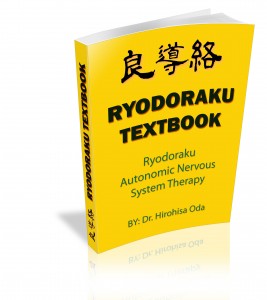What is Ryodoraku?
RYODORAKU AUTONOMIC NERVOUS SYSTEM THERAPY
Hirohisa Oda
Ryodoraku Autonomic Nervous System Therapy (RANS Therapy) was devised and advocated in the 1950’s, by the late Dr. Nakatani, from the Kyoto University School of Medicine, Department of Physiology, which was under the supervision of the late Professor Sasagawa.
The Acupuncture point can be classified into two categories: the Reactive Point, which may be a Miscellaneous Hypersensitive Point, a lump, a hard muscular mass, or a point of low electrical resistance, and the Indicated Point which is not required to demonstrate a physiological reaction, rather it is indicated or selected by pulse diagnosis and symptomatic pattern analysis according to Traditional Chinese Medical Theory.
It is believed by nearly all practitioners that the electropermeable point is a good, effective treatment point for stimulus therapy, and it is the Acupuncture point.
The Meridian point shows physiological or pathological low electric resistance, especially when the patient has a disease or symptomatic complaints which influence the autonomic nervous system.
Today, an electropermeable point, which shows a physiological change of resistance in comparison to its surrounding tissue, that changes with time like the tide, is called a Ryodo point. A point which shows pathological low electrical resistance and a structural change in the cell membrane is called a Reactive Ryodo point, commonly referred to in Japan as Hanno (meaning reactive) Ryodo point. The Reactive Ryodo point does not change position for a few days.
Before Dr. Nakatani, there were many researchers who said that the electropermeable point was an acupuncture point. Dr. Nakatani noticed that points differed in electrical permeability. He then arranged these electropermeable points (Ryodo points) into functional groups according to meridian concepts, and referred to them as Ryodoraku, electropermeable points grouped together in the Central Nervous System like a constellation.
Dr. Nakatani devised the idea of using a Ryodoraku Representative Measurement Point (RRMP) for each Ryodoraku. Nearly all the Representative points were positioned near the Traditional Source Points, except for the Large Intestine and Kidney Representative Measurement Point which are placed at slightly different positions.
Electrical skin resistance is measured with a neurometer with an indifferent hand grip, dry electrode and 1 cm in diameter moist search electrode. The electrical conditions are direct current 12 volts and 200 µA when both electrodes are connected.
A relative comparison of values for each Ryodoraku is plotted on the nomogram shown below. The position of values on the nomogram represents the level of the patient’s metabolism. The measurement value on an RRMP mainly represents the degree of perspiration. According to principle component analysis, the permeability of the cutaneous cellular membrane follows a similar pattern.
The pattern plotted on the nomogram elicits the law of hemiperspiration phenomena which was discovered by Professor emeritus, Takagi, from the Nagoya University School of Medicine. As in the law of hemiperspiration, the nomogram illustrates a difference in, that is a separation of Hand and Foot groups. This phenomena is also seen in traditional Chinese medicine. In TCM, human Qi is differentiated by its function and location, i.e. Qi in the upper part of the body is referred to as Fire, referring to the Heart function and Qi in the lower part of the body is referred to as Water, referring to the Kidney function. Furthermore, the nomogram is also similar to TCM theory in its differentiation of left and right sides of the body, and between Yin (inner side of the body) and Yang (the outer sides of the body), a differentiation which appeared on the Yellow Emperor’s Inner Classic.
To regulate the Autonomic Nervous System, the practitioner can refer to the comparative plotted position of each Ryodoraku. The nomogram allows a certain range for physiological change which is recognized as a very short-lived change in Galvanic Skin Resistance and more importantly, statistical measurement error.
Since this range also includes statistical error, it could more accurately be called the permitted range. The width of this range is 1.4 cm, or 0.7 mm, from the average line, printed on both sides of the nomogram scale.
To regulate Ryodoraku which deviate from the permitted range, or so called physiological range, one may choose a stimulus therapy from acupuncture, moxibustion, Chinese medicine, or Western medicine.
Acupuncture with direct current on sedating or tonifying points, according to the RANS nomogram, accompanied with stimulation of the reactive point is especially effective and is very widely used. The RANS nomogram is a useful diagnostic aid which can also be used as a basis for Chinese or Western style medical treatment.
Related sites that might interest you
- Acupuncture Point Diagram : Abs Fat Burning Tips
- Body or Sharir in Hinduism XXVII « TRUTH
- What Controls Economies? « LaMarotte
- Articles highlight challenges, progress in nervous system cancers …
- HP Invents a Central Nervous System for the Earth | Inhabitat
- Cannasat batting hot streak in its CNS turnaround | BioTuesday
- Recognizing Acute and Continual Lyme Disease Symptoms
- Weight Loss With Acupuncture And Chinese Medicine | Daily Health …
- Yin Chiao – How to Use Yin Chiao Chieh Tu Pien – Chinese Medicine Gem
- What does chinese medicine say about the nose and possible …

